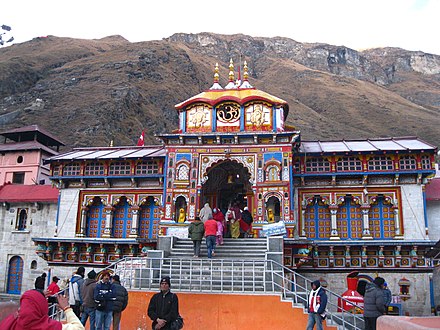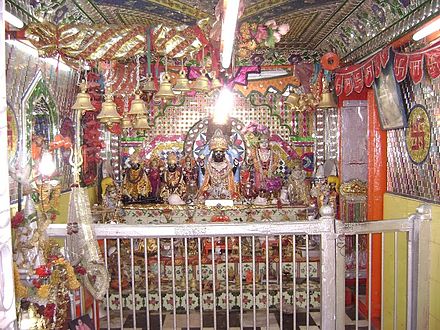Badrinath - holy town and a nagar panchayat in Chamoli district in the state of Uttarakhand, India

Badrinath is a Hindu holy town and a nagar panchayat in Chamoli district in the state of Uttarakhand, India. Badrinath is the most important of the four sites in India's Char Dham pilgrimage. Badrinath is in the Garhwal hills, on the banks of the Alaknanda River, at an elevation of 3133 m. The holy shrine here is the Badrinath Temple dedicated to Hindu god Vishnu. The temple is stated to be of Vedic origin and over the years has undergone many renovations.
Get in
By plane
The nearest airport is the Jolly Grant Airport near Dehradun, about 337 km from Badrinath.
By rail
The nearest railway stations to Badrinath are at Rishikesh and Kotdwar, which are at a distance of 297 km and 327 km respectively.
By bus
There are regular buses operating to Badrinath from Delhi, Haridwar and Rishikesh.
By car
There are certain timings to visit Badrinath by car/bike after opening of the temple, as routes are narrow from Pandukeshwar on some places. As of 2018, roads are open by the time 8AM to 8PM. There is a checkpost near Pandukeshwar, around 23 km from Joshimath (a good place for a journey break). So check the timings before start your journey.
Get around
 Only a few kilometres from the India-China (Tibet) border, Badrinath is generally a two-day-long journey from either Kedarnath, the site that precedes it in the Char Dham circuit, or one of the main disembarkation points on the plains. Hemkund Sahib, an important Sikh pilgrimage site, is on the way to Badrinath, so the road is especially crowded during the summer pilgrimage season. The temple and its substantial surrounding village are accessible by road. One can visit the last Indian village Mana during the visit of the temple which is around 4 km from the temple and easily accessible by the roads. Many people prefer to reach Badrinath shrine starting early morning from Joshimath have darshan of Lord Vishnu and return to Joshimath by evening to avoid any altitude problems.
The temple is open only from May to October and the dates are announced through the media.
Only a few kilometres from the India-China (Tibet) border, Badrinath is generally a two-day-long journey from either Kedarnath, the site that precedes it in the Char Dham circuit, or one of the main disembarkation points on the plains. Hemkund Sahib, an important Sikh pilgrimage site, is on the way to Badrinath, so the road is especially crowded during the summer pilgrimage season. The temple and its substantial surrounding village are accessible by road. One can visit the last Indian village Mana during the visit of the temple which is around 4 km from the temple and easily accessible by the roads. Many people prefer to reach Badrinath shrine starting early morning from Joshimath have darshan of Lord Vishnu and return to Joshimath by evening to avoid any altitude problems.
The temple is open only from May to October and the dates are announced through the media.
Climate
The area experiences a cool and chilly climate all through the year. May to June and again from September to October are the best period to visit. Winter is severe and snowfall is common. The monsoon period from July to mid September is best avoided for your journey as landslides and road blocks are quite common.
See
- Nar Narayan Temple. 2015-05-24
- Vasudhara Falls, 30.78801°, 79.44992°. The first 3 km can be travelled by a car or a bus. This stop is called "Mana". First point after the village Mana, the last habitat in the Indian side, is Bhim Pool. This is said to have been built by Bhim (of the Pandavas from the Mahabharata epic) for his wife Draupadi who could not cross the ridge. From here, there is a 4 km trek to the falls. No special gear for the trek is needed apart from some sturdy shoes.
- Hemkund Sahib. Hemkunt Sahib is a pilgrimage site for Sikhs. It is believed that Guru Gobind Singh ji, the tenth guru of the Sikhs, spent 10 years in meditation at this spot. The gurudwara is located amidst snow-capped Garhwal mountains and snuggled between the peaks of the Hemkund Parvat. This gurudwara is visited by devotees from all over the country. Many pilgrims also visit to repair the trail that is often damaged in winters. 2022-10-27
- Satopanth Tal. Satopanth Tal is a pristine glacial lake surrounded by mighty peaks like Chaukhamba, Neelkantha, Swargarohini and Balakun. This triangular lake is a challenging trek (25 km from Badrinath) and one of the hidden gems of the Garhwal region. Locals say this lake is where gods Brahma, Vishnu and Shiva meditated. The trek to Satopanth is takes you past Mana, India’s last village, the popular Vasudhara waterfall and the Sahastradhara falls. 2022-10-27
- Mana Village. Mana is the last Indian village towards the international border. With small houses and narrow lanes leading up towards the mountains, the village is pretty like in a fairytale. It falls on several popular trekking routes and is around 4 km from Badrinath. 2022-10-27
- Vyas gufa. This is a sacred site near Badrinath at a distance of 4 km. It is said that it was here that the great sage Ved Vyas documented the epic Mahabharata with the help of Lord Ganesha. 2022-10-27
Do
- Brahma Kapal. Brahma Kapal Ghat is situated on the banks of the Alakananda River. It is said that Lord Brahma, the Creator resides here. It is 100 m to the north of the Badrinath Temple. Hindu devotees perform shraddha, an homage and rituals for the departed souls, on the banks of the river at this site.
- Hot Geyser. There is a hot spring near the temple. Many saints live in the surrounding mountains all year round despite the harsh winter at such high elevations.
- Origin of Saraswati river. Located near Mana village, this is said to be the origin of the Saraswati river coming out and going underground again. This river is not visible anywhere from its source up to Allahabad Sangam in UP, where it is said to merge into Ganga river along with Yamuna river. Very close to the visible part of the river Saraswati, there is very small water stream said to be water from Mansarover Lake in Tibet.
- Tapt Kund (Narad Kund). Tapt kund is a natural thermal spring where the devotees take a holy dip before proceeding to the main temple of badrinath. It is also believed to possess medicinal value good for skin 2019-04-15
Buy
Ancient coins, wool, Ayurvedic medicine, holy books, counterfeit electronic goods from China, sacred threads, seashells, temple requirements, aarti booklets, colourful beads and bracelets.
Eat
Indian and only vegetarian food. Non vegetarian foods are not allowed on this pilgrimage route beyond Rishikesh. There are several eateries around the temple some of which have decent eating atmosphere. Do not expect luxury as all business here are seasonal. All shops remains closed after the yatra season is over.
- Saket Restaurant, Badrinath Temple Access Path, 30.744642°, 79.49232°, +91 381 222228. Daily 7AM-10PM. Reasonable variety of vegetarian Indian and Chinese. 2018-07-19
Drink
No alcohol permitted, but (illegal) marijuana, etc., is widely available.
Sleep
Lots of hotels and ashrams. If you are low on cash you can always stay in an ashram; food is also provided by ashrams. If you are adventurous you can bring along your tents and camp here. There are some locals who can also provide you ready-made tents to stay. Hotel Narayan Palace, near the bus stand, and Sarovar Portico are luxury hotels with a reasonable tariff.
- New Hotel Snow Crest, Main Road Badrinath Dham, 30.74051°, 79.49617°, +91 98730 82465, hotel_snowcrest@yahoo.com. Many rooms offer views of the 6,500 m high Neelkanth ('Blue Neck') mountain. The heating and electricity within the hotel is reliable. 2018-07-19
Go next
Chamoli
2nd-order administrative division
Uttarakhand
Primary administrative division
